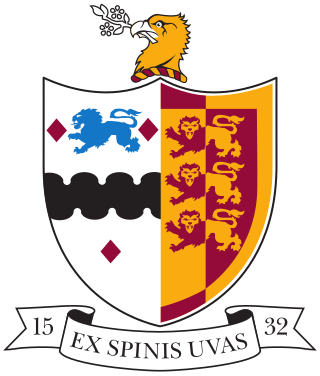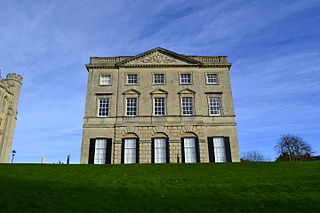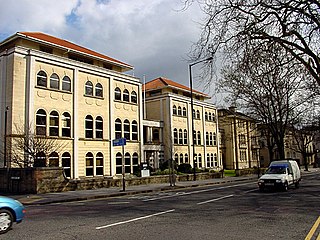
Chippenham is a market town in north-west Wiltshire, England. It lies 13 miles (21 km) north-east of Bath, 86 miles (138 km) west of London and is near the Cotswolds Area of Outstanding Natural Beauty. The town was established on a crossing of the River Avon, where some form of settlement is believed to have existed since before Roman times. It was a royal vill and probably a royal hunting lodge, under Alfred the Great. The town continued to grow when the Great Western Railway arrived in 1841. It had a population of 36,548 in 2021.

Lytham St Annes is a seaside town in the Borough of Fylde in Lancashire, England. It is on the Fylde coast, directly south of Blackpool on the Ribble Estuary. The population of the built-up area at the 2021 census was 42,695. The town is made up of the four areas of Lytham, Ansdell, Fairhaven and St Annes-on-the-Sea.

Clifton Hill House is a Grade I listed Palladian villa in the Clifton area of Bristol, England. It was the first hall of residence for women in south-west England in 1909 due to the efforts of May Staveley. It is still used as a hall of residence by the University of Bristol.

Clifton is both a suburb of Bristol, England, and the name of one of the city's thirty-five council wards. The Clifton ward also includes the areas of Cliftonwood and Hotwells. The eastern part of the suburb lies within the ward of Clifton Down.

Bristol Grammar School (BGS) is a 4–18 mixed, private day school in Bristol, England. It was founded in 1532 by Royal Charter for the teaching of 'good manners and literature', endowed by wealthy Bristol merchants Robert and Nicholas Thorne who made their money through the work and trade of enslaved Africans. The school flourished in the early 20th century under headmaster Sir Cyril Norwood (1906–1916), embodying "the ideals and experiences of a leading public school". Norwood went on to serve as the master at Marlborough College and Harrow, and as president of St John's College, Oxford.

Ashton Court is a mansion house and estate to the west of Bristol in England. Although the estate lies mainly in North Somerset, it is owned by the City of Bristol. The mansion and stables are a Grade I listed building. Other structures on the estate are also listed.

The Avon Gorge is a 1.5-mile (2.5-kilometre) long gorge on the River Avon in Bristol, England. The gorge runs south to north through a limestone ridge 1.5 miles (2.4 km) west of Bristol city centre, and about 3 miles (5 km) from the mouth of the river at Avonmouth. The gorge forms the boundary between the unitary authorities of North Somerset and Bristol, with the boundary running along the south bank. As Bristol was an important port, the gorge formed a defensive gateway to the city.

Prior Park is a Neo-Palladian house that was designed by John Wood, the Elder, and built in the 1730s and 1740s for Ralph Allen on a hill overlooking Bath, Somerset, England. It has been designated as a Grade I listed building.

Blaise Castle is a folly built in 1766 near Henbury in Bristol, England. The castle sits within the Blaise Castle Estate, which also includes Blaise Castle House, a Grade II* listed 18th-century mansion house. The folly castle is also Grade II* listed and ancillary buildings including the orangery and dairy also have listings. Along with Blaise Hamlet, a group of nine small cottages around a green built in 1811 for retired employees, and various subsidiary buildings, the parkland is listed Grade II* on the Register of Historic Parks and Gardens of special historic interest in England.

Eastville is a suburb and electoral ward in Bristol, England. As an informally defined neighbourhood, Eastville long existed without official boundaries, and the area that has been formally defined for the electoral ward includes neighbourhoods that might not traditionally have been thought of as part of Eastville, while omitting part of the area that is commonly thought of Eastville.

Bristol, the largest city in South West England, has an eclectic combination of architectural styles, ranging from the medieval to 20th century brutalism and beyond. During the mid-19th century, Bristol Byzantine, an architectural style unique to the city, was developed, and several examples have survived.

Cabot was a council ward that covered the centre of Bristol, England. It took its name from the Cabot Tower, a memorial tower on Brandon Hill that was built to commemorate John Cabot's voyage and "discovery" of North America. The ward was abolished in 2016.
Sea Mills is a suburb of Bristol, England, 3.5 miles (6 km) north-west of the city centre, between the former villages of Shirehampton, Westbury-on-Trym and Stoke Bishop, by the mouth of the River Trym where it joins the River Avon.

The English city of Bristol has a number of parks and public open spaces.

Whiteladies Road is a main road in Bristol, England. It runs north from the Victoria Rooms to Durdham Down, and separates Clifton on the west side from Redland and Cotham on the east. It forms part of the A4018.

Park Street is a major shopping street in Bristol, England, linking the city centre to Clifton. It forms part of the A4018.

The Royal Fort House is a historic house in Tyndalls Park, Bristol. The building currently houses the University of Bristol's Faculty of Science offices, the Brigstow Institute, Elizabeth Blackwell Institute for Health Research, the Cabot Institute and the Jean Golding Institute for data-intensive research.

The University of Bristol Botanic Garden is a botanical garden in Bristol, England. The garden moved to its current site in Stoke Bishop in 2005, having previously been at two other sites in the city. The 4,500 species of plants are displayed in collections relating to evolution, Mediterranean, local flora and rare natives and finally useful plants.

The BBC campus, Broadcasting House Bristol, is located on Whiteladies Road, Bristol. The first building to be occupied was 21/23 Whiteladies Road, which was built in 1852 and is a Grade II listed building, with four radio studios. It was formally opened by the Lord Mayor of Bristol on 18 September 1934. The BBC has been on the same site ever since.

Montpelier is an inner suburban area of Brighton, part of the English city and seaside resort of Brighton and Hove. Developed together with the adjacent Clifton Hill area in the mid-19th century, it forms a high-class, architecturally cohesive residential district with "an exceptionally complete character". Stucco-clad terraced housing and villas predominate, but two of the city's most significant Victorian churches and a landmark hospital building are also in the area, which lies immediately northwest of Brighton city centre and spreads as far as the ancient parish boundary with Hove.




















